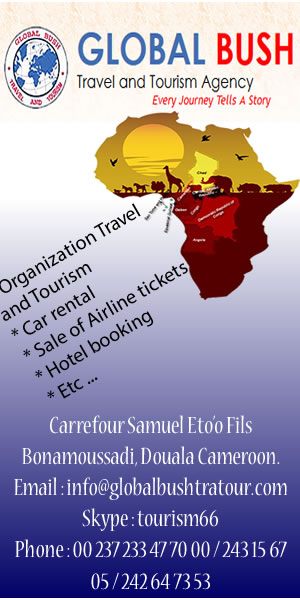 The Musée d’Art Camerounais forms part of Yaounde Benedictine monastery in the lea of Mt Fébé. It has a wonderful collection of masks, bronzes, wooden bas-reliefs and pottery. Look out for the brass sculpture of the ‘Great Maternal Figure’, from the area northeast of Foumban – similar sculpture is still produced at Foumban’s Village des Artisans. The monastery’s chapel (underneath the main church) is decorated with Cameroonian textiles and crafts, and kora are sometimes used to accompany the singing at Mass.
The Musée d’Art Camerounais forms part of Yaounde Benedictine monastery in the lea of Mt Fébé. It has a wonderful collection of masks, bronzes, wooden bas-reliefs and pottery. Look out for the brass sculpture of the ‘Great Maternal Figure’, from the area northeast of Foumban – similar sculpture is still produced at Foumban’s Village des Artisans. The monastery’s chapel (underneath the main church) is decorated with Cameroonian textiles and crafts, and kora are sometimes used to accompany the singing at Mass.
The museum has a really handy English/French guidebook available at the entrance.Take a shared taxi to Bastos and then change for Mt Fébé.
This large government-run establishment is a good place to get an idea of what handicrafts are available in Cameroon, although prices are little good. Wood carving figures highly in what’s on offer.
Just north of Bamenda is the large Tikar community of Bafut, traditionally the most powerful of the Grassfields kingdoms. The fon’s (local chief’s) palace here is home to a 700-year-old dynasty and is a fascinating insight into traditional culture.
 The palace compound consists of numerous buildings, including the houses of the fon’s 150-or-so wives (not all of whom are presently in residence), and the sacred Achum building, which is off-limits to everyone except the fon and his close advisors. In front of the palace compound are several stones marking the burial sites of nobles who died while serving the fon, and the Takombang House which holds the fon’s ceremonial drum.
The palace compound consists of numerous buildings, including the houses of the fon’s 150-or-so wives (not all of whom are presently in residence), and the sacred Achum building, which is off-limits to everyone except the fon and his close advisors. In front of the palace compound are several stones marking the burial sites of nobles who died while serving the fon, and the Takombang House which holds the fon’s ceremonial drum.
Trekking in the spectacular landscapes of the Mandara Mountains west of Maroua is one of Cameroon’s best and most popular attractions, especially for the more adventurous travellers. The whole region is full of traditional hillside villages of round huts, huge stone formations and wide green valleys.
There are many fascinating villages, including Rhumsiki, with its striking mountain scenery; Djingliya and Koza, set against steep terraced hillsides; Tourou, known for the calabash hats worn by local women; Maga, with its unique domed houses made entirely of clay; and Mora, which has a particularly notable weekly market. Hiking between villages is one of the best ways to app…
 Waza National Park is Cameroon’s most accessible and rewarding wildlife-viewing experience. Visitors can reasonably expect to see large numbers of elephants, giraffes, hippos, antelopes, monkeys and abundant birdlife. There are lions in the park, but seeing them requires some luck and a very early start.
Waza National Park is Cameroon’s most accessible and rewarding wildlife-viewing experience. Visitors can reasonably expect to see large numbers of elephants, giraffes, hippos, antelopes, monkeys and abundant birdlife. There are lions in the park, but seeing them requires some luck and a very early start.
Late March to April is the best time for viewing, as the animals congregate at water holes before the rains.
Although it’s not put on for tourists, the Ewondo-language Open-Air Mass outside the Paroisse de N’Djong Melen in Quartier Melen attracts many visitors. It’s well worth a visit, but put on your Sunday best like everyone else. It begins at 09:30 on Sunday and features drums, dancing and a women’s chorus. It’s on the western side of town, and reached by shared taxi.
Ever popular, the laid-back atmosphere here is accentuated by mellow live music every evening. Dishes are a mix of Cameroonian and continental standards, but choose the draught beer over the bottles, it’s a lot cheaper. As we went to press, rumours were that the restaurant was moving to Ave Churchill.
The Musée Afhemi is actually in a private residence, but it’s more of a gallery than a home. The collection of Cameroonian and regional artwork reflects the owner’s eclectic tastes. Call in advance to arrange a tour in English and, possibly, lunch. It’s 6km southeast of the centre.
This bright place serves up a menu straight from an American diner, with a few Lebanese and Italian dishes thrown in for good measure. The bean burritos are real winners, and the vegetarian pasta a treat for those suffering from a surfeit of meaty Cameroonian stews.



![cameroon-art-museum[1]](https://www.globalbushtratour.com/blog/wp-content/uploads/2011/12/cameroon-art-museum1-300x291.jpg)















Leave a comment
You must be logged in to post a comment.